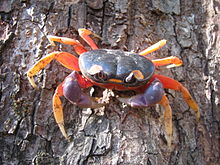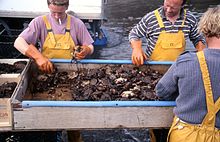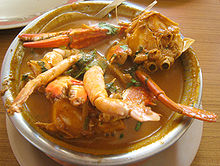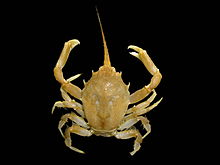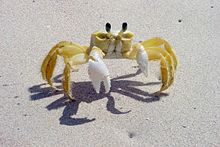- Crab
-
For other uses, see Crab (disambiguation).
Crabs
Temporal range: Jurassic–Recent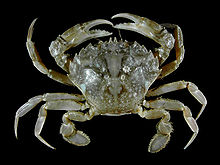
Liocarcinus vernalis Scientific classification Kingdom: Animalia Phylum: Arthropoda Subphylum: Crustacea Class: Malacostraca Order: Decapoda Suborder: Pleocyemata Infraorder: Brachyura
Linnaeus, 1758Sections & subsections [1] - Dromiacea
- Raninoida
- Cyclodorippoida
- Eubrachyura
- Heterotremata
- Thoracotremata
True crabs are decapod crustaceans of the infraorder Brachyura, which typically have a very short projecting "tail" (Greek: βραχύς / brachys = short,[2] οὐρά / οura = tail[3]), or where the reduced abdomen is entirely hidden under the thorax. Many other animals with similar names – such as hermit crabs, king crabs, porcelain crabs, horseshoe crabs and crab lice – are not true crabs.
Contents
Evolution
Crabs are generally covered with a thick exoskeleton, and armed with a single pair of chelae (claws). Crabs are found in all of the world's oceans, while many crabs live in fresh water and on land, particularly in tropical regions. Crabs vary in size from the pea crab, a few millimetres wide, to the Japanese spider crab, with a leg span of up to 4 metres (13 ft).[4]
About 850 species of crab are freshwater, terrestrial or semi-terrestrial species;[5] they are found throughout the world's tropical and semi-tropical regions. They were previously thought to be a monophyletic group, but are now believed to represent at least two distinct lineages, one in the Old World and one in the New World.[6]
The earliest unambiguous crab fossils date from the Jurassic,[7] although Carboniferous Imocaris, known only from its carapace, may be a primitive crab.[8] The radiation of crabs in the Cretaceous and afterward may be linked either to the break-up of Gondwana or to the concurrent radiation of bony fish, crabs' main predators.[9]
Sexual dimorphism
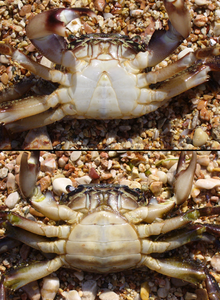 The underside of a male (top) and a female (bottom) individual of Pachygrapsus marmoratus, showing the difference in shape of the abdomen
The underside of a male (top) and a female (bottom) individual of Pachygrapsus marmoratus, showing the difference in shape of the abdomen
Crabs often show marked sexual dimorphism. Males often have larger claws,[10] a tendency which is particularly pronounced in the fiddler crabs of the genus Uca (Ocypodidae). In fiddler crabs, males have one claw which is greatly enlarged and which is used for communication, particularly for attracting a mate.[11] Another conspicuous difference is the form of the pleon (abdomen); in most male crabs, this is narrow and triangular in form, while females have a broader, rounded abdomen.[12] This is due to the fact that female crabs brood fertilised eggs on their pleopods.
Behaviour
Crabs typically walk sideways[13] (a behaviour which gives us the word crabwise). This is because of the articulation of the legs which makes a sidelong gait more efficient.[14] However, some crabs walk forwards or backwards, including raninids,[15] Libinia emarginata[16] and Mictyris platycheles.[13] Some crabs, notably the Portunidae and Matutidae, are also capable of swimming.[17]
Crabs are mostly active animals with complex behaviour patterns. They can communicate by drumming or waving their pincers. Crabs tend to be aggressive towards one another and males often fight to gain access to females.[18] On rocky seashores, where nearly all caves and crevices are occupied, crabs may also fight over hiding holes.[19]
Crabs are omnivores, feeding primarily on algae,[20] and taking any other food, including molluscs, worms, other crustaceans, fungi, bacteria and detritus, depending on their availability and the crab species. For many crabs, a mixed diet of plant and animal matter results in the fastest growth and greatest fitness.[21][22]
Crabs are known to work together to provide food and protection for their family, and during mating season to find a comfortable spot for the female to release her eggs.[23]
Human consumption
Fisheries
Main article: Crab fisheriesCrabs make up 20% of all marine crustaceans caught, farmed, and consumed worldwide, amounting to 1½ million tonnes annually. One species, Portunus trituberculatus, accounts for one fifth of that total. Other commercially important taxa include Portunus pelagicus, several species in the genus Chionoecetes, the blue crab (Callinectes sapidus), Charybdis spp., Cancer pagurus, the Dungeness crab (Metacarcinus magister) and Scylla serrata, each of which yields more than 20,000 tonnes annually.[24]
Cookery
Further information: Category:Crab dishesCrabs are prepared and eaten as a dish in several different ways all over the world. Some species are eaten whole, including the shell, such as soft-shell crab; with other species just the claws and/or legs are eaten. The latter is particularly common for larger crabs, such as the snow crab. Mostly in East Asian cultures, the roe of the female crab is also eaten, which usually appears orange or yellow in color in fertile crabs.
In some regions spices improve the culinary experience. In Asia, masala crab and chilli crab are examples of heavily spiced dishes. In the Chesapeake Bay region, blue crab is often eaten with Old Bay Seasoning.
For the British dish Cromer crab, the crab meat is extracted and placed inside the hard shell. One American way to prepare crab meat is by extracting it and adding a flour mix, creating a crab cake.
Crabs are also used in bisque, a global dish of French origin.
Pain
Main article: Pain in crustaceansLive crabs are often boiled. In 2005, Norwegian scientists concluded that lobsters cannot feel pain.[25] However, later research suggests that crustaceans are indeed able to feel and remember pain.[26][27]
Classification
The infraorder Brachyura contains 6,793 species in 93 families,[17] as many as the remainder of the Decapoda.[28] The evolution of crabs is characterised by an increasingly robust body, and a reduction in the abdomen. Although many other groups have undergone similar processes, carcinisation is most advanced in crabs. The telson is no longer functional in crabs, and the uropods are absent, having probably evolved into small devices for holding the reduced abdomen tight against the sternum.
In most decapods, the gonopores (sexual openings) are found on the legs. However, since crabs use the first two pairs of pleopods (abdominal appendages) for sperm transfer, this arrangement has changed. As the male abdomen evolved into a narrower shape, the gonopores have moved towards the midline, away from the legs, and onto the sternum.[29] A similar change occurred, independently, with the female gonopores. The movement of the female gonopore to the sternum defines the clade Eubrachyura, and the later change in the position of the male gonopore defines the Thoracotremata. It is still a subject of debate whether those crabs where the female, but not male, gonopores are situated on the sternum, form a monophyletic group.[28]
Superfamilies
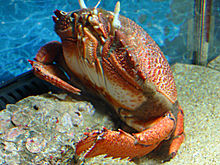 Ranina ranina (Raninoida: Raninidae)
Ranina ranina (Raninoida: Raninidae)
Numbers of extant and extinct (†) species are given in brackets.[17] The superfamily Eocarcinoidea, containing Eocarcinus and Platykotta, was formerly thought to contain the oldest crabs; it is now considered part of the Anomura.[30]
- Section Dromiacea
- Dakoticancroidea (6†)
- Dromioidea (147, 85†)
- Glaessneropsoidea (45†)
- Homolodromioidea (24, 107†)
- Homoloidea (73, 49†)
- Section Raninoida (46, 196†)
- Section Cyclodorippoida (99, 27†)
- Section Eubrachyura
- Subsection Heterotremata
- Aethroidea (37, 44†)
- Bellioidea (7)
- Bythograeoidea (14)
- Calappoidea (101, 71†)
- Cancroidea (57, 81†)
- Carpilioidea (4, 104†)
- Cheiragonoidea (3, 13†)
- Corystoidea (10, 5†)
- Componocancroidea (1†)
- Dairoidea (4, 8†)
- Dorippoidea (101, 73†)
- Eriphioidea (67, 14†)
- Gecarcinucoidea (349)
- Goneplacoidea (182, 94†)
- Hexapodoidea (21, 25†)
- Leucosioidea (488, 113†)
- Majoidea (980, 89†)
- Orithyioidea (1)
- Palicoidea (63, 6†)
- Parthenopoidea (144, 36†)
- Pilumnoidea (405, 47†)
- Portunoidea (455, 200†)
- Potamoidea (662, 8†)
- Pseudothelphusoidea (276)
- Pseudozioidea (22, 6†)
- Retroplumoidea (10, 27†)
- Trapezioidea (58, 10†)
- Trichodactyloidea (50)
- Xanthoidea (736, 134†)
- Subsection Thoracotremata
- Cryptochiroidea (46)
- Grapsoidea (493, 28†)
- Ocypodoidea (304, 14†)
- Pinnotheroidea (304, 13†)
Cultural influences
Both the constellation Cancer and the astrological sign Cancer are named after the crab, and depicted as a crab. William Parsons, 3rd Earl of Rosse drew the Crab Nebula in 1848 and noticed its similarity to the animal; the Crab pulsar lies at the centre of the nebula.[31]
The Moche people of ancient Peru worshipped nature, especially the sea,[32] and often depicted crabs in their art.[33] In Greek mythology, Karkinos was a crab that came to the aid of the Lernaean Hydra as it battled Heracles.
References
- ^ Sammy De Grave, N. Dean Pentcheff, Shane T. Ahyong et al. (2009). "A classification of living and fossil genera of decapod crustaceans" (PDF). Raffles Bulletin of Zoology Suppl. 21: 1–109. http://rmbr.nus.edu.sg/rbz/biblio/s21/s21rbz1-109.pdf.
- ^ Henry George Liddel & Robert Scott. "βραχύς". A Greek–English Lexicon. Perseus Digital Library. http://www.perseus.tufts.edu/hopper/text?doc=Perseus%3Atext%3A1999.04.0057%3Aentry%3Dbraxu%2Fs. Retrieved May 24, 2010.
- ^ Henry George Liddel & Robert Scott. "οὐρά". A Greek–English Lexicon. Perseus Digital Library. http://www.perseus.tufts.edu/hopper/text?doc=Perseus%3Atext%3A1999.04.0057%3Aentry%3Dou%29ra%2F. Retrieved May 24, 2010.
- ^ "Japanese spider crab Macrocheira kaempferi". Oceana North America. http://na.oceana.org/en/explore/creatures/japanese-spider-crab. Retrieved January 2, 2009.
- ^ R. von Sternberg & N. Cumberlidge (2001). "On the heterotreme-thoracotreme distinction in the Eubrachyura De Saint Laurent, 1980 (Decapoda: Brachyura)". Crustaceana 74 (4): 321–338. doi:10.1163/156854001300104417.
- ^ R. von Sternberg, N. Cumberlidge & G. Rodriguez (1999). "On the marine sister groups of the freshwater crabs (Crustacea: Decapoda: Brachyura)". Journal of Zoological Systematics and Evolutionary Research 37: 19–38. doi:10.1046/j.1439-0469.1999.95092.x.
- ^ Carrie E. Schweitzer & Rodney M. Feldmann (2010). "The oldest Brachyura (Decapoda: Homolodromioidea: Glaessneropsoidea) known to date (Jurassic)". Journal of Crustacean Biology 30 (2): 251–256. doi:10.1651/09-3231.1.
- ^ Frederick Schram & Royal Mapes (1984). "Imocaris tuberculata, n. gen., n. sp. (Crustacea: Decapoda) from the upper Mississippian Imo Formation, Arkansas". Transactions of the San Diego Society of Natural History 20 (11): 165–168. http://www.biodiversitylibrary.org/item/25402#183.
- ^ J. W. Wägele (1989). "On the influence of fishes on the evolution of benthic crustaceans" (PDF). Zeitschrift für Zoologische Systematik und Evolutionsforschung 27 (4): 297–309. doi:10.1111/j.1439-0469.1989.tb00352.x. http://www.zfmk.de/web/ZFMK_Mitarbeiter/WgeleJW/Publikationen/Publikationen/1989OntheinfluenceoffishesevolutionofBenthic.pdf.
- ^ L. H. Sweat (August 21, 2009). "Pachygrapsus transversus". Smithsonian Institution. http://www.sms.si.edu/irLspec/Pachyg_transv.htm. Retrieved January 20, 2010.
- ^ M. J. How, J. M. Hemmi, J. Zeil & R. Peters (2008). "Claw waving display changes with receiver distance in fiddler crabs, Uca perplexa". Animal Behaviour 75 (3): 1015–1022. doi:10.1016/j.anbehav.2007.09.004. http://richard.eriophora.com.au/pubs/pdf/HowHemmiZeilPeters-07.pdf.
- ^ Guillermo Guerao & Guiomar Rotllant (2009). "Post-larval development and sexual dimorphism of the spider crab Maja brachydactyla (Brachyura: Majidae)". Scientia Marina 73 (4): 797–808. doi:10.3989/scimar.2009.73n4797. http://digital.csic.es/bitstream/10261/19120/3/1148.pdf.
- ^ a b Sally Sleinis & Gerald E. Silvey (1980). "Locomotion in a forward walking crab". Journal of Comparative Physiology A: Neuroethology, Sensory, Neural, and Behavioral Physiology 136 (4): 301–312. doi:10.1007/BF00657350.
- ^ Andy Horton & Jane Lilley. "Why do crabs walk sideways?". British Marine Life Study Society. http://homepages.ed.ac.uk/evah01/crabs.htm. Retrieved January 5, 2009.
- ^ "Spanner crab Ranina ranina". Fishing and Aquaculture. New South Wales Department of Primary Industries. 2005. http://www.dpi.nsw.gov.au/fisheries/recreational/saltwater/sw-species/spanner-crab. Retrieved January 4, 2009.
- ^ A. G. Vidal-Gadea & J. H. Belanger (2009). "Muscular anatomy of the legs of the forward walking crab, Libinia emarginata (Decapoda, Brachyura, Majoidea)". Arthropod Structure & Development 38 (3): 179–194. doi:10.1016/j.asd.2008.12.002. PMID 19166968.
- ^ a b c Peter K. L. Ng, Danièle Guinot & Peter J. F. Davie (2008). "Systema Brachyurorum: Part I. An annotated checklist of extant Brachyuran crabs of the world" (PDF). Raffles Bulletin of Zoology 17: 1–286. http://rmbr.nus.edu.sg/rbz/biblio/s17/s17rbz.pdf.
- ^ "Crab (animal)". Encarta. Microsoft. 2005.
- ^ The Miles Kelly Book of Life. Great Bardfield, Essex: Miles Kelly Publishing. 2006. pp. 512. ISBN 978-1842367155.
- ^ C. M. C. Woods (1993). "Natural diet of the crab Notomithrax ursus (Brachyura, Majidae) at Oaro, South Island, New Zealand". New Zealand Journal of Marine and Freshwater Research 27 (3): 309–315. doi:10.1080/00288330.1993.9516571. http://www.rsnz.org/publish/nzjmfr/1993/29.php.
- ^ Kennish, R. (1996). "Diet composition influences the fitness of the herbivorous crab Grapsus albolineatus". Oecologia 105 (1): 22–29. doi:10.1007/BF00328787. http://www.springerlink.com/content/l7m3368427059312/.
- ^ T. L. Buck, G. A. Breed, S. C. Pennings, M. E. Chase, M. Zimmer & T. H. Carefoot (2003). "Diet choice in an omnivorous salt-marsh crab: different food types, body size, and habitat complexity". Journal of Experimental Marine Biology and Ecology 292 (1): 103–116. doi:10.1016/S0022-0981(03)00146-1. http://cat.inist.fr/?aModele=afficheN&cpsidt=14847986.
- ^ Danièle Guinot & J.–M. Bouchard (1998). "Evolution of the abdominal holding systems of brachyuran crabs (Crustacea, Decapoda, Brachyura)" (PDF). Zoosystema 20 (4): 613–694. http://www.mnhn.fr/publication/zoosyst/z98n4a4.html.
- ^ "Global Capture Production 1950-2004". FAO. http://www.fao.org/figis/servlet/TabLandArea?tb_ds=Capture&tb_mode=TABLE&tb_act=SELECT&tb_grp=COUNTRY. Retrieved August 26, 2006.
- ^ David Adam (February 8, 2005). "Scientists say lobsters feel no pain". The Guardian. http://www.guardian.co.uk/world/2005/feb/08/research.highereducation.
- ^ "Crabs 'feel and remember pain' suggests new study". CNN. March 27, 2009. http://edition.cnn.com/2009/WORLD/europe/03/27/crabs.memorypain/.
- ^ Robert W. Elwood & Mirjam Appel (2009). "Pain experience in hermit crabs?" (PDF). Animal Behaviour 77 (5): 1243–1246. doi:10.1016/j.anbehav.2009.01.028. http://forms.mbl.edu/research/services/iacuc/pdf/pain_hermit_crabs.pdf.
- ^ a b Joel W. Martin & George E. Davis (2001) (PDF). An Updated Classification of the Recent Crustacea. Natural History Museum of Los Angeles County. pp. 132. http://atiniui.nhm.org/pdfs/3839/3839.pdf.
- ^ M. de Saint Laurent (1980). "Sur la classification et la phylogénie des Crustacés Décapodes Brachyoures. II. Heterotremata et Thoracotremata Guinot, 1977". Comptes rendus de l'Académie des sciences t. 290: 1317–1320.
- ^ Jérôme Chablais, Rodney M. Feldmann & Carrie E. Schweitzer (2011). "A new Triassic decapod, Platykotta akaina, from the Arabian shelf of the northern United Arab Emirates: earliest occurrence of the Anomura" (PDF). Paläontologische Zeitschrift 85: 93–102. doi:10.1007/s12542-010-0080-y. http://decapoda.nhm.org/pdfs/31744/31744.pdf.
- ^ B. B. Rossi (1969). The Crab Nebula: Ancient History and Recent Discoveries. Center for Space Research, Massachusetts Institute of Technology. CSR-P-69-27. http://ntrs.nasa.gov/search.jsp?R=19700008151.
- ^ Elizabeth Benson (1972). The Mochica: A Culture of Peru. New York, NY: Praeger Press. ISBN 9780500720011.
- ^ Katherine Berrin & Larco Museum (1997). The Spirit of Ancient Peru:Treasures from the Museo Arqueológico Rafael Larco Herrera. New York: Thames and Hudson. pp. 216. ISBN 978-0500018026.
External links
 Media related to Brachyura at Wikimedia Commons
Media related to Brachyura at Wikimedia Commons Data related to Brachyura at Wikispecies
Data related to Brachyura at Wikispecies
Superfamilies of Infraclass Brachyura (true crabs) Dromiacea 
Raninoida RaninoideaCyclodorippoida Eubrachyura HeterotremataAethroidea · Bellioidea · Bythograeoidea · Calappoidea · Cancroidea · Carpilioidea · Cheiragonoidea · Componocancroidea† · Corystoidea · Dairoidea · Dorippoidea · Eriphioidea · Gecarcinucoidea · Goneplacoidea · Hexapodoidea · Leucosioidea · Majoidea · Orithyioidea · Palicoidea · Parthenopoidea · Pilumnoidea · Portunoidea · Potamoidea · Pseudothelphusoidea · Pseudozioidea · Retroplumoidea · Trapezioidea · Trichodactyloidea · XanthoideaPrincipal commercial fishery species groups Wild Forage fishOther wild fishMolluscs- Sea cucumbers
- Sea urchin
- more...



Farmed Categories:- Crabs
- Edible crustaceans
- Commercial crustaceans
Wikimedia Foundation. 2010.

